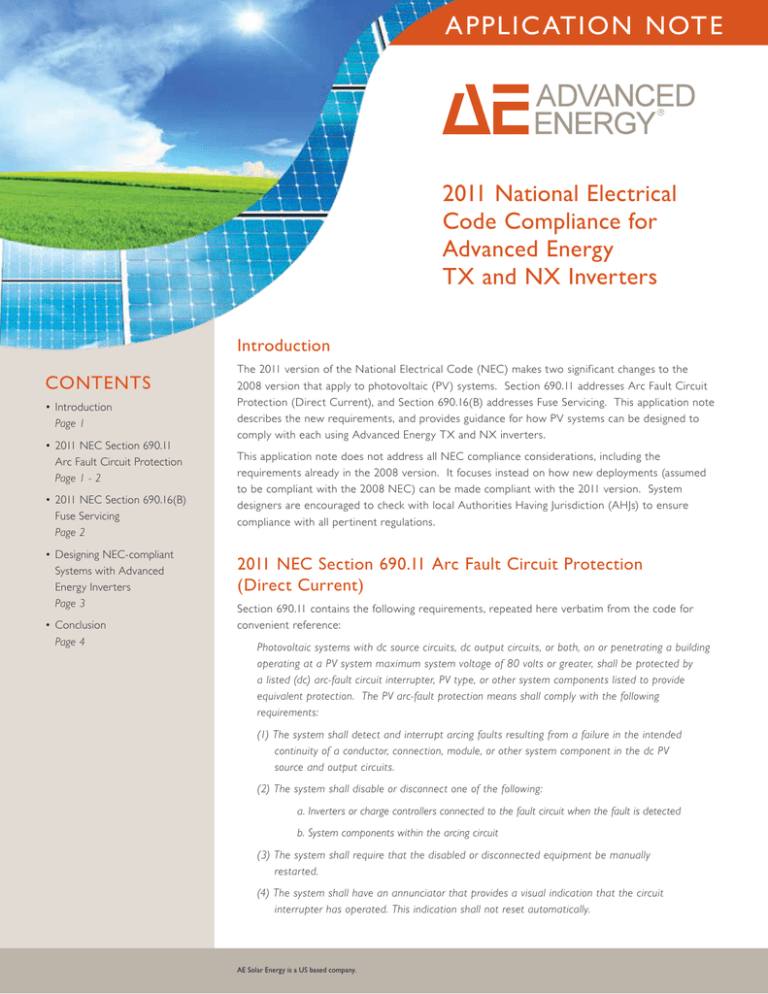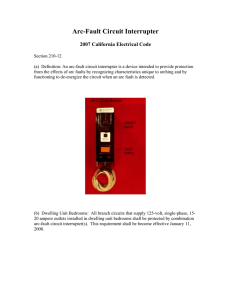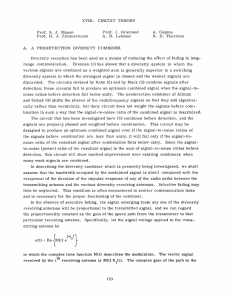
APPLIC ATION NOTE
2011 National Electrical
Code Compliance for
Advanced Energy
TX and NX Inverters
Introduction
CONTENTS
•Introduction
Page 1
•2011 NEC Section 690.11
Arc Fault Circuit Protection
Page 1 - 2
•2011 NEC Section 690.16(B)
Fuse Servicing
Page 2
•Designing NEC-compliant
Systems with Advanced
Energy Inverters
Page 3
•Conclusion
Page 4
The 2011 version of the National Electrical Code (NEC) makes two significant changes to the
2008 version that apply to photovoltaic (PV) systems. Section 690.11 addresses Arc Fault Circuit
Protection (Direct Current), and Section 690.16(B) addresses Fuse Servicing. This application note
describes the new requirements, and provides guidance for how PV systems can be designed to
comply with each using Advanced Energy TX and NX inver ters.
This application note does not address all NEC compliance considerations, including the
requirements already in the 2008 version. It focuses instead on how new deployments (assumed
to be compliant with the 2008 NEC) can be made compliant with the 2011 version. System
designers are encouraged to check with local Authorities Having Jurisdiction (AHJs) to ensure
compliance with all per tinent regulations.
2011 NEC Section 690.11 Arc Fault Circuit Protection
(Direct Current)
Section 690.11 contains the following requirements, repeated here verbatim from the code for
convenient reference:
Photovoltaic systems with dc source circuits, dc output circuits, or both, on or penetrating a building operating at a PV system maximum system voltage of 80 volts or greater, shall be protected by a listed (dc) arc-fault circuit interrupter, PV type, or other system components listed to provide equivalent protection. The PV arc-fault protection means shall comply with the following requirements:
(1) The system shall detect and interrupt arcing faults resulting from a failure in the intended continuity of a conductor, connection, module, or other system component in the dc PV source and output circuits.
(2) The system shall disable or disconnect one of the following:
a. Inverters or charge controllers connected to the fault circuit when the fault is detected
b. System components within the arcing circuit
(3) The system shall require that the disabled or disconnected equipment be manually restarted.
(4) The system shall have an annunciator that provides a visual indication that the circuit interrupter has operated. This indication shall not reset automatically.
AE Solar Energy is a US based company.
APPLIC ATION NOTE
Combiner Box with
Arc Fault Detector
and DAQ
The purpose of this new section is to reduce the potential for
PV system fires caused by series arc faults anywhere in the DC
circuitry. The code requires the PV system to have the means
to detect DC series arc faults and to isolate the arcing line,
and that the circuit affected must be manually reset. Figure 1
shows an example of an NEC 2011-compliant combiner box
with integrated Arc Fault Detector and Data Acquisition (DAQ)
circuit installed.
Inverter
Figure 1 – Shown here is a circuit with a combiner-integrated
Arc Fault Circuit Interruption and a series arc fault in a string.
Common causes of DC arc faults include loose connections
between modules, damaged DC cables, and improperly torqued
combiner box connections. While these failure causes usually
exist upon commissioning, they can also develop over time due
to thermal or mechanical cycle fatigue.
Figure 2 – Loose connectors are a common cause of arc faults.
Image credit: Phoenix Contact
It is impor tant to note that for this code cycle Section 690.11
requires the use of Arc Fault Circuit Interruption (AFCI)
equipment only for PV systems that are connected to buildings
(e.g. roof-top systems), and not for ground-mount systems.
Because AFCI only became a requirement in 2011, standards for
the design and testing of solutions are only now being developed.
As of this writing, for example, very few manufacturers have
AFCI devices listed for compliant use. Underwriters Laboratories
has created a new standard (UL 1699B) for testing AFCI
equipment, and a growing number of vendors are now subjecting
their solutions to these tests.
Page 2
For this reason, some AHJs have provided waivers for Section
690.11 compliance. Such waivers are permitted under NEC
Section 90.4, which permits an exemption for new code
requirements when the technology needed for compliance is not
yet commercially available. The issuance of waivers is likely to
continue until commercial solutions are tested for compliance
and made available for deployment.
Advanced Energy expects AFCI solutions to be implemented
in string inver ters and combiner boxes, rather than in central
inver ters, for two reasons. One is that detecting arc faults in
central inver ters is technically challenging; as amperage increases,
so too does system noise, making string-level arcing difficult to
detect at the inver ter. The other involves the requirement that
the arcing loop remain offline until the fault has been found and
fixed. The advantage of string- and combiner-level detection is
that isolating the PV system at these points reduces power loss
during troubleshooting, and decreases the time it takes to find
and fix the fault.
2011 NEC Section 690.16(B)
Fuse Servicing
Section 690.16(B) contains the following requirements, repeated
here verbatim from the code for convenient reference:
Disconnecting means shall be installed on PV output circuits where overcurrent devices (fuses) must be serviced that cannot be isolated from energized circuits. The disconnecting means shall be within sight of, and accessible to, the location of the fuse or integral with fuse holder and shall comply with 690.17. Where the disconnecting means are located more than 1.8m (6 ft) from the over current device, a directory showing the location of each disconnect shall be installed at
the overcurrent device location.
Non-load-break-rated disconnecting means shall be marked
“Do not open under load.”
Previous versions of the NEC required a disconnecting means,
but did not specify a location. For example, the disconnecting
means could have been in roof-mounted combiner boxes, while
the inver ter was on the ground. In some cases, this led to
unsafe work practices if a disconnecting means was not readily
accessible. This new section in the NEC now requires that the
disconnecting means be within sight of the fuses.
APPLIC ATION NOTE
Figure 3 shows the additional disconnecting means required for
fused sub-array combiners. The purpose of this change is to
enhance human safety by ensuring that DC source circuits are
not live during overcurrent device servicing.
Combiner
Box
Inverter
DC
Disconnect
AC
Disconnect
Additional Disconnects Required
per 2011 NEC 690.16 [B]
Combiner
Box
Figure 3 – The additional disconnecting means required under
Section 690.16(B) are shown here highlighted in red. In this
example, the potential exists to service fuses while DC circuits
are live.
Because this new requirement places limitations on inver ters
with integral fused sub-array combiners, the change is likely to
drive inver ter manufacturers away from fused subsystems that
have a down-stream disconnect, and towards breaker-based
subsystems with dead-fronts. This is par ticularly true because
system-level compliance can easily be achieved using external
disconnects.
Designing NEC-Compliant Systems with
Advanced Energy Inverters
Table 1 summarizes the combiner, recombiner, and inver ter
requirements for 2011 NEC compliance in PV systems using
Advanced Energy TX series inverters. Note that
for rooftop systems, all TX inver ters require an AFCI for the
combiner boxes (except in cases where a waiver has been
issued by the AHJ). For ground-mount systems, there is no
such requirement for an AFCI.
Combiner Box
Requirements
AE 35TX
AE 50TX
AFCI Combiner
required for rooftop
applications*
AE 75TX
AE 100TX
AFCI Combiner
required for rooftop
applications*
AE 250TX
AE 260TX
AFCI Combiner
required for rooftop
applications*
AE 500TX
AFCI Combiner
required for rooftop
applications*
Combiner
Box
Fused
Sub-array
Combiner
Combiner
Box
Table 1 – Quick-guide to NEC 2011 Compliant Systems for
TX inverters
Recombiner / Inverter
Requirements
No recombiner required for single
combiner box installation. Inverter has
integrated dc disconnect for service.
Option a) External disconnect required
with optional inverter-integrated
subcombiner.
Option b) If an external circuit breaker
based recombiner is used, the inverter has
an integrated dc disconnect for service.
Option a) Optional inverter integrated
circuit breaker based subcombiner available
in 2H 2013.
Option b) If an external circuit breaker
based recombiner is used, the inverter has
an integrated dc disconnect for service.
Inverter integrated circuit breaker
subcombiner option
*As solutions are tested and become available
Refer to the AE 500TX Integrated DC circuit breaker based
subcombiner option application note from Advanced Energy
for more information on inver ter integrated circuit breaker
subcombiners.
Table 2 summarizes the combiner, recombiner, and inver ter
requirements for 2011 NEC compliance in PV systems using
Advanced Energy NX series inverters. Note that
for rooftop systems, all NX inver ters require an AFCI for the
combiner boxes (except in cases where a waiver has been
issued by the AHJ). For ground-mount systems, there is no
such requirement for an AFCI.
Table 2 – Quick-guide to NEC 2011 Compliant Systems for
NX inverters
Inverter
Combiner Box
Requirements
Recombiner
Requirements
AE 250NX
AE 333NX
AE 500NX
AFCI Combiner
required for rooftop
applications*
Use the inverter Field Wiring Enclosure
(FWE) option with a disconnecting or
circuit breaker based recombiner or
disconnect.
AE 1000NX
AFCI Combiner
required for rooftop
applications*
No external recombiner is required with
standard integrated contactor based DC
subcombiner.
*As solutions are tested and become available
Page 3
APPLIC ATION NOTE
Conclusion
Safety is the purpose of the National Electrical Code, and the 2011 version enhances worker
safety with two new provisions that are applicable to PV systems: DC arc fault circuit protection
and fuse servicing. Because NEC enforcement varies greatly by region, system designers are
encouraged to consult with the AHJs to determine if and how these new provisions are being
enforced, and whether or not a waiver is available until AFCI equipment can be tested and made
commercially available.
These new provisions will require changes to be made to combiner boxes, recombiners, inver ters,
and system designs. Advanced Energy will be monitoring these changes and will provide regular
updates about compatibility of new AFCI equipment and other solutions with the TX and NX
series of inver ters in an *NEC Compatibility Table on our website. Additional information about
NEC compliance and other design considerations can also be obtained by calling AE Solar Energy’s
service team at (877)312-3832.
* http://solarenergy.advanced-energy.com/upload/file/applicationnotes/neccompatibilitytable.pdf
AE Solar Energy • 20720 Brinson Blvd • Bend, OR 97701 U.S.A.
www.advanced-energy.com/solarenergy
877.312.3832 • sales.support@aei.com • invertersupport@aei.com
Please see www.advanced-energy.com for worldwide contact information.
Advanced Energy is a registered U.S. trademark of Advanced Energy Industries, Inc.
© Advanced Energy Industries, Inc.
All rights reserved. Printed in U.S.A.
ENG-NEC-260-01 4/13


